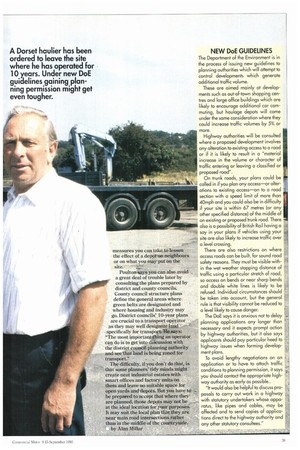A 10-year battle against a planning order to quit his depot
Page 42

Page 43

If you've noticed an error in this article please click here to report it so we can fix it.
'n the Dorset green belt around Poole and Bournemouth has just ended in defeat for John Coakes. The haulier, based at Corfe Mullen, lost a High Court appeal against the Department of the Environment's decision not to allow him retrospective planning permission for his depot on what was an old pig farm.
Now he is having to negotiate a mutually agreed early date to move off the site and he is faced with a hefty legal bill for the costs of the High Court hearing. He feels aggrieved and he admits to being perplexed by the fact that East Dorset District Council appears to have pursued its case against Coakes Transport while other businesses have been granted _ planning permission for industrial premises in the greenbelt.
"We are only 100m from the boundary of a big quarry which they plan to turn into an infill site over the next 25 years," he says.
The council's principal planning officer, Kevin Poulton, says the quarry is an exceptional case. "You can generally only extract minerals from the green belt, which is why it has been permitted, but transport doesn't need to be in the green belt." Where Coakes went wrong—twice, he says—was in trying to establish a transport depot in the green belt. It might have been a different story had the depot been there before the green belt was designated, but its chances of success were slim at so late a date. Poulton puts it more strongly: "Unless there is a planning history of the site for transport use, it is a bit foolhardy seeking to establish use later."
Planning experts point out that there is nothing illegal about seeking retrospective planning permission. Businesses, and especially small ones such as Coakes Transport, can innocently fail foul of the planning authority by doing something that turns out to require planning permission: retrospective permission exists to meet such cases.
But the problem with the green belt, in this particular case an area about five to eight miles wide around the outskirts of urban east Dorset, is that the law is written to make it exceptionally difficult to build anything in the protected countryside.
As Poulton points out, you start off at a greater disadvantage than if you wanted planning permission for a site somewhere less sensitive. "Green belt is different from all other planning concerns," he says. "In non-green belt sites, there is always a presumption in favour of the applicant and it is up to objectors to prove their case. But with green belt, the presumption is almost in reverse. It is up to the applicant to say why it should be given special authority in these circumstances."
So, if you are going to avoid the fate of Coakes Transport, how do you keep on the right side of the planning authorities? Poulton's advice is simple: "Make sure that where you're going to set up a depot is lawful. The last thing anyone, including the local authority, wants is a prolonged battle."
Several property surveyors in the commercial market have planning departments which, for an agreed fee, will act on your behalf and take you through the procedures and recommend a course of action appropriate to your case.
Or you may wish to deal direct with the local authority. If you approach the local planners before you do anything, they may well be able to talk you through the details of what is and is not possible in your own area.
Councils do not have hard and fast national rules for transport development, but they can tell you what may be acceptable for a given size of fleet in a particular location and could advise you either on the measures you can take to lessen the effect of a depot on neighbours or on what you may put on the site.
Poulton says you can also avoid a great deal of trouble later by consulting the plans prepared by district and county councils.
County council structure plans define the general areas where green belts are designated and where housing and industry may go. District councils' 10-year plans are crucial to a transport operator as they may well designate land specifically for transPort.lie says: "The most itnportantithing an operator can do is to get into dricussion with the district council planning authority and seethatland is being zoned for transport."
The difficulty, if-you don't do that, is that some planners' tidy minds might create neat industrial estates with smart offices and factory units on them and leave no suitable space for open yards and depots. But you have to be prepared to accept that where they are planned, those depots may not be at the ideal location for your purposes. It may suit the local plan that they are near main road intersections rather than in the middle of the countryside. I I by Alan Millar


























































































